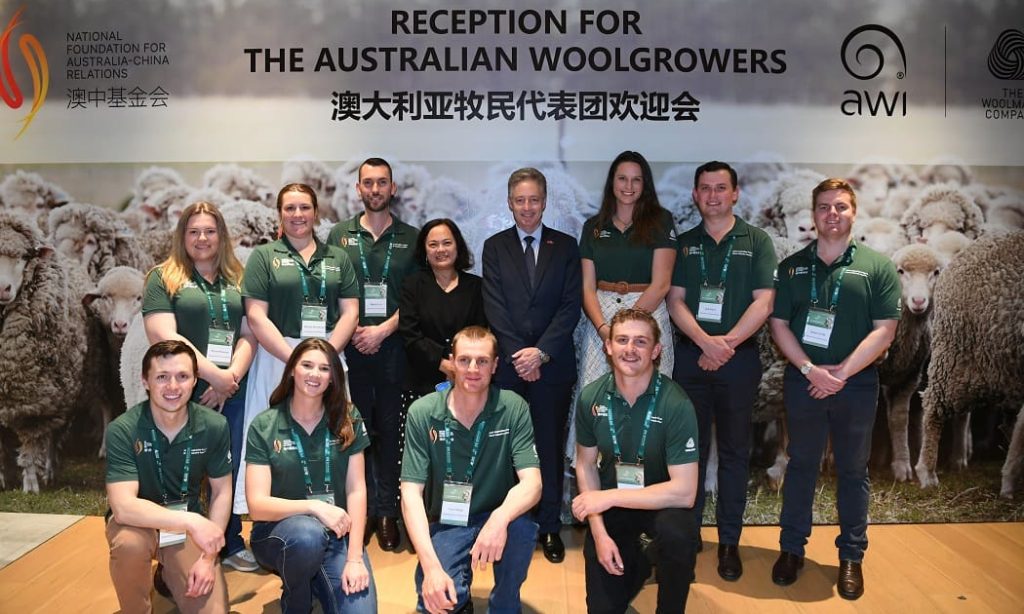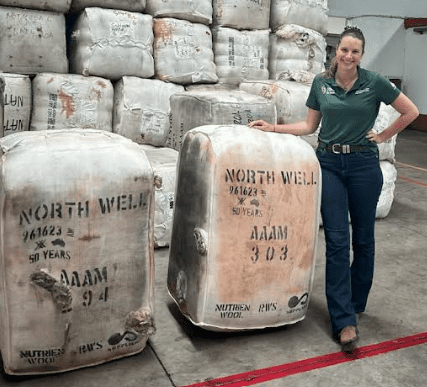
The Australian future wool industry leaders group.
AUSTRALIAN wool growers and brokers were impressed by evidence of increased investment in wool processing in China during a recent Australian Wool Innovation-organised tour by future industry leaders.
But Australia’s decreasing wool supply, its impact on future prices and the cost pressures on young wool growers were also key topics of discussions during the tour of Chinese wool processing mills and attendance at the Nanjing Wool Market Conference.
AWI said 10 Australian future wool industry leaders were on the AWI tour, funded partly by a grant provided by the Australian Government’s National Foundation for Australia-China Relations.
AWN’s general manager – wool in Victoria Ben Stace said the investment of Chinese processors in automating processing plants with robotics filled him with confidence for the future.
“So they are heavily invested as well and fully reliant on the Australian wool clip in order to have the throughput through their plants.”
One of the business visited was Redsun, renamed Sunwoo, which has put A$200 million into refitting a factory.
“The message that I came away with was if our largest export partners are investing that sort of money into a plant that is set for processing wool that has got to be a good thing for us.”
Mr Stace said the Chine wool supply chain is full; with plenty of tops, noils and wool grease in stock.
“Business is OK for the circular knitters, but the main message is that until consumer demand returns things will remain a bit static.”
Mr Stace said last year China imported 294 million kilograms of raw wool from Australia, while the nation’s wool production this year is forecast at 285 million kgs.
“So we are undershooting what China took by 9-10 million kilograms, plus whatever will end up in Italy and other countries.
“So if you look at the supply-demand equation, you would think with production falling back, when the market does lift and demand returns, I would expect some significant upside … we just don’t know when that will be.”
Australia’s production, price and grower intentions

Wool grower and advocate Kate McBride with some North Well bales.
Wool grower and advocate Kate McBride said noted that the Chinese processing investment was being made in wool-specific mills.
“It has also been amazing to see the investment in the wool industry over here and it makes us feel the future of wool is bright.
“While there are many challenges we face with wool growing, especially low prices at the moment, we are grateful to have a partner in China that understands these challenges.”
She said one of the big “takeaways” from the trip was discussion around Australia’s wool production relative to China’s processing requirements.
“There was a lot of talk about Australia’s (wool) production and the 10 percent decrease in the forecasts that we are seeing for next year.
“With China taking so much of our wool and at the Nanjing Wool Conference there was talk about the fact that next year with our production decreasing, they will essentially need to take 100 percent of our clip to maintain their needs,” she said.
“So that discussion around supply and demand was really interesting.”
She said there was a lot of talk about the unsustainability of the current wool prices paid to growers.
“There is a reason that we are seeing these massive decreases in wool production.
“One of the clear messages I heard over there, and it was said on stage at the Nanjing conference, was that Australian growers are landholders, they’re not just wool growers, and if the price isn’t there then they will shift to other enterprises,” Kate said.
“I think the reality of the fact that we are not going to be producing enough wool to feed their needs and this trend will only continue was certainly heard.
“A 10 percent decrease is massive, so I think there is an inevitability about it, whether at what point next year it will be, eventually as people continue to move out of wool, we are going to see that supply and demand dynamic,” she said.
Kate said there was also discussion about the impact of the recent economic stimulus package in China and the growing middle class.
“A number of the big mills that we spoke to are aware of the challenges (faced by Australian growers) because they farms in Australia that actually produce wool.
“There were questions put to the young wool growers about what do we need to stay in the industry and it really came down to the prices,” she said.
The young growers also cited the increases in shearing and running costs as factors.
“Price was absolutely number one and I spoke to them about how in western New South Wales we are seeing massive shifts by people who were Merino wool growers into Dorpers … and that unfortunately the (wool) prices just aren’t sustainable for us to keep going.”
“There was talk about people going into cattle as well and unless the wool price is there we can’t stick with it.”
Kate said the Chinese were told the young growers still saw a future in wool, but needed to act as partners with the processors.
“When we’re not doing well our industry is going to struggle and our production is going to decrease.”
At the Nanjing conference, Kate said it was interesting to see a number of Chinese processors commit to putting money into fighting the European Product Environmental Footprint legislation that effectively colour-coded wool as “bad.” Most PEF work on behalf of wool has been funded by AWI and the International Wool Textile Organisation.
“That was powerful to see.
“I think it (PEF) is a big risk for our wool industry but it’s a good outcome to have the Chinese industry committing money in this space to advocate alongside us.”
Kate said a highlight of the trip was finding some McBride wool bales, from the family’s North Well station in South Australia, in one of the factories, prompting a rash of personal and group selfies.
An opportunity for business and cultural exchange – AWI
AWI chief executive John Roberts said the study tour provided an opportunity for business and cultural exchange.
“This was an outstanding group of young people involved in the wool industry and showed the strong commitment and passion of Australian wool industry youth engaging with key partners throughout the wool supply chain,” he said.
“The group was nominated and selected through AWI’s Wool Industry Consultation Panel with selection criteria based around demonstrated commitment to the industry as an industry volunteer or ongoing career development and their drive for engagement of the wool supply chain.
“The group aged between 20 and 30 years were representatives across five states.”
The 10-day program included visits to Icicle Flagship Store & ‘The Beast Home’ homeware in Shanghai, Donghua University/Wool Education Centre, Tianyu, JHT Wuxi, Redsun/Sunwoo, Xinao Spinning, Shanghai Challenge & vertically integrated Nanshan Group (Longkou).
A key part of the tour was attendance and participation in the 35th Nanjing Wool Market Conference in Tongxiang, attended by over 400 internal wool delegates from all major woolgrowing countries and included the IWTO president Klaus Steger.
At an Australian wool grower reception attended by more than 50 key Australian and Chinese traders the Future Wool Industry Leader group engaged with delegates across all sectors of the industry.
Australian Council of Wool Exporters and Processors president Josh Lamb echoed the group’s positive sentiment and said they were a credit to the industry
“The Future Wool Industry Leaders Tour is a great partnership by AWI and the National Foundation for Australia-China Relations.
“They are great group of young people with common goals in mind for wool’s success but with very diverse ideas and experience.”
The NFACR grant funding will also be used for a reciprocal arrangement to bring future wool industry leaders from China to Australia at the start of 2025 and then a second Australian delegation will go to China in mid-2025.
Also in the 2024 Future Wool Industry Leaders group were Western Australian grower and researcher Brittany Bolt, New South Wales growers Tom Sleigh and Miranda McGufficke, Victorian grower Clive Silcock, Queensland Shute Bell Badgery Lumby broker and grower Jack Finch, NSW grower and sheep classer Padraic Lowe, and NSW grower Emma Pearson.